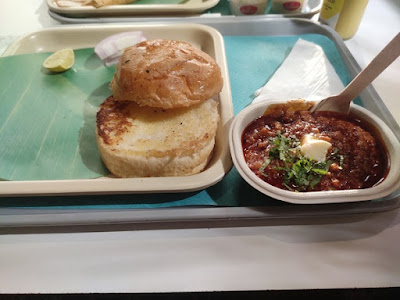Pav Bhaji is a popular Indian street food that originated in the bustling streets of Mumbai. It is a delectable combination of spicy mashed vegetables cooked with aromatic spices, served alongside buttery and toasted pav (soft bread rolls). This mouthwatering dish has gained immense popularity across India and beyond, thanks to its rich flavors and irresistible appeal.
Pav Bhaji Secret Ingredient –
To prepare Pav Bhaji, you will need:
- 4 medium-sized potatoes, boiled and mashed
- 1 cup cauliflower, finely chopped
- 1 cup green peas
- 1 large onion, finely chopped
- 2 tomatoes, finely chopped
- 1 capsicum (bell pepper), finely chopped
- 4-5 cloves of garlic, minced
- 2 tablespoons pav bhaji masala
- 1 teaspoon red chili powder
- 1/2 teaspoon turmeric powder
- Salt to taste
- 4 tablespoons butter
- 8 pav (bread rolls)
- Chopped coriander leaves, for a finishing touch.
Directions to Cook Pav Bhaji Masala :
- Heat a tablespoon of butter in a pan and add grind garlic. Sauté until golden brown.
- Add chopped onions and cook until translucent. Then, add tomatoes and cook until they turn soft.
- Add cauliflower, green peas, and capsicum. Cook it for a 2-3 minutes until the vegetables are soft.
- Mash the boiled potatoes and add them to the pan. Mix well.
- Sprinkle pav bhaji masala, red chili powder, turmeric powder, and salt. Stir to combine.
- Add the water and let the mixture of vegetables boil for 10–15 minutes. Season with salt, pepper, and other desired herbs and spices.
- Meanwhile, slice the pav rolls and toast them with butter on a griddle until golden brown.
- Once the bhaji (mixture) thickens, garnish it with chopped coriander leaves.
How to Prepare Pav Bhaji:
To prepare Pav Bhaji, follow these steps:
- Boil and mash the potatoes.
- Chop the vegetables finely.
- Sauté garlic, onions, and tomatoes in butter.
- Add the vegetables and mashed potatoes.
- Sprinkle spices and salt, mix well.
- Simmer the mixture for 10-15 minutes.
- Toast the pav rolls with butter.
- Garnish the bhaji with chopped coriander leaves.
Preparation Time For Pav Bhaji:
The preparation time for Pav Bhaji is approximately 30 minutes, including the time required for chopping vegetables and boiling potatoes.
Servings:
This recipe serves 4 people comfortably, so it’s perfect for a casual get-together or a cozy night in with your loved ones.
Conclusion:
Pav Bhaji is a crowd-pleasing dish that brings together a medley of flavors and textures. This beloved street food delicacy is easy to prepare and guarantees to tantalize your taste buds. Whether you’re hosting a party, craving a quick meal, or simply looking to savor an authentic Indian recipe, Pav Bhaji is a surefire winner. Don’t miss the opportunity to treat yourself to this irresistible blend of vegetables, spices, and soft bread rolls. So, gather your ingredients, follow the simple steps, and get ready to enjoy a truly delightful culinary experience with Pav Bhaji!
FAQs – Mumbai Special Pav Bhaji Recipe
Can I use frozen vegetables for Pav Bhaji?
Yes, you can use frozen vegetables if fresh ones are not available.
Can I make Pav Bhaji without butter?
No. Butter adds richness and flavor to the dish, you can use oil instead if you prefer a healthier option.
What can I serve with Pav Bhaji?
Pav Bhaji pairs well with sliced onions, lemon wedges, and a dollop of butter. You can also serve it with salad or pickles.
Can I adjust the spice level of Pav Bhaji?
Absolutely! Feel free to adjust the amount of red chili powder and pav bhaji masala according to your taste preferences.
Can I freeze leftover Pav Bhaji?
Yes, you can store leftover Pav Bhaji in an airtight container and freeze it for later use. Reheat it on the gas or in the microwave before serving.
How to make pav bhaji at home in English?
To make pav bhaji at home, follow these steps:
> Boil and mash potatoes.
> Chop vegetables finely.
> Sauté garlic, onions, and tomatoes in butter.
> Add vegetables and mashed potatoes.
> Sprinkle spices and salt, mix well.
> Simmer the mixture for 10-15 minutes.
> Toast the pav rolls with butter.
> Garnish the bhaji with chopped coriander leaves.
> Serve hot with pav, sliced onions, and lemon wedges.
Is Pav Bhaji a Junk Food?
Pav bhaji can be considered a fast food dish, but it doesn’t necessarily qualify as junk food. By using fresh vegetables, controlling the amount of butter, and opting for whole wheat pav, you can make a healthier version at home.
What is Pav Bhaji Masala Made Of?
Pav bhaji masala is a made of various spices like Coriander Seeds, Cumin Seeds, Cloves, Fennel Seeds, Black Cardamom, Cinnamon, Dry Mango Powder, Black Pepper, Turmeric, and Red Chili Powder. The combination of these spices gives pav bhaji its distinct and flavorful taste.
Which state is pav bhaji famous?
Pav bhaji is famous across India, but it originated in Maharashtra, particularly in Mumbai. It is a beloved street food in Mumbai and has gained popularity throughout the country.
Is homemade pav bhaji healthy?
Homemade pav bhaji can be a healthier option compared to the ones served in restaurants or street stalls. By controlling the amount of butter, using fresh and quality ingredients, and opting for whole wheat pav, you can make it a nutritious and balanced meal.
Why is pav bhaji so tasty?
Pav bhaji owes its delectable taste to the harmonious blend of spices, the combination of various vegetables, and the addition of butter.
What is the Pav bhaji ingredients List?
Secret Ingredients of pav bhaji include Potato, Cauliflower, Green Peas, Onions, Tomato, Capsicum, Garlic, Pav Bhaji Masala, Red Chili Powder, Turmeric Powder, Salt, Butter, Pav (Bread ), and Fresh Coriander Leaves for garnish.

Bhawna Anand is a talented content writer and editor with over 5 years of experience crafting engaging content for Abmantra, a popular blogging website. Her areas of expertise include Fashion, Festival, Gifting, Ecommerce, Spiritual and Travel content. Bhawna’s informative and engaging writing style has helped Abmantra attract a loyal readership and build a strong online community.
When not at work, Bhawna enjoys traveling the world, which often inspires her to write captivating travel pieces that transport readers to new destinations. She also loves to sing, cook, and read good novels.

